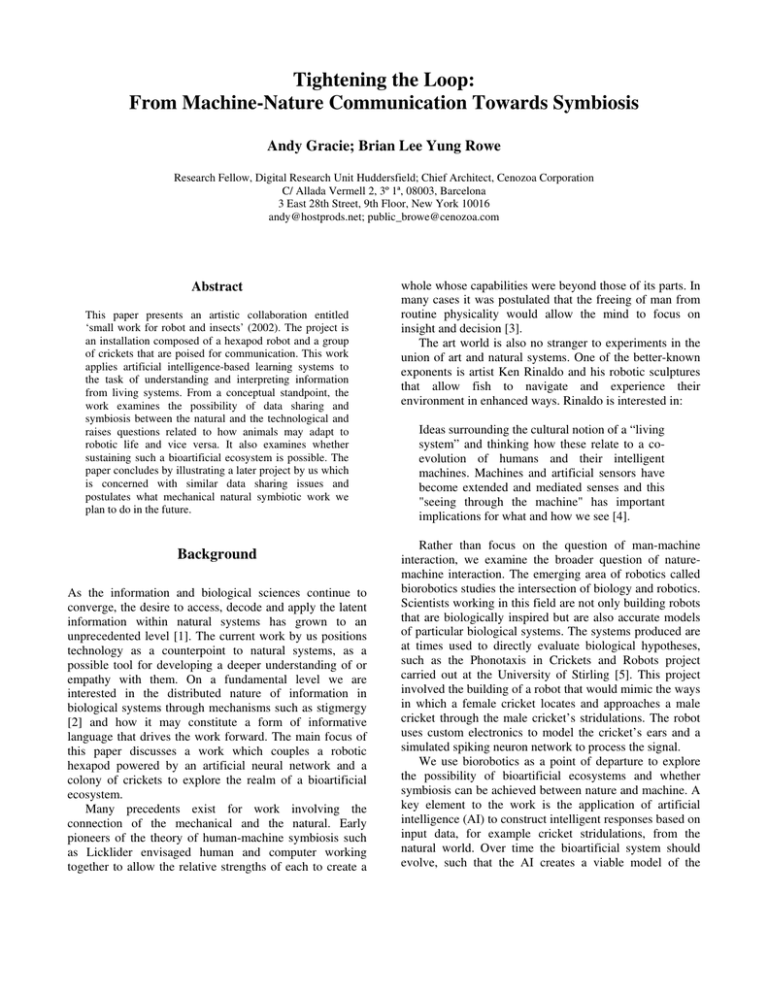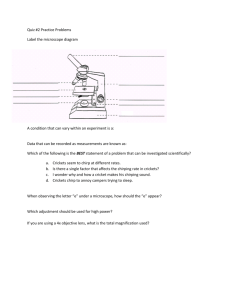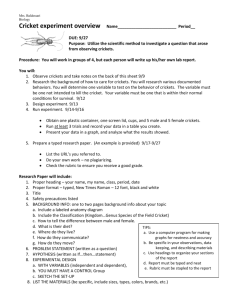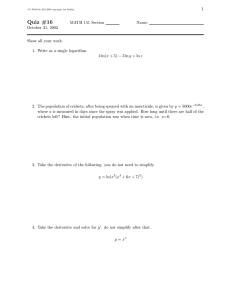Tightening the Loop: From Machine-Nature Communication Towards Symbiosis
advertisement

Tightening the Loop: From Machine-Nature Communication Towards Symbiosis Andy Gracie; Brian Lee Yung Rowe Research Fellow, Digital Research Unit Huddersfield; Chief Architect, Cenozoa Corporation C/ Allada Vermell 2, 3º 1ª, 08003, Barcelona 3 East 28th Street, 9th Floor, New York 10016 andy@hostprods.net; public_browe@cenozoa.com Abstract This paper presents an artistic collaboration entitled ‘small work for robot and insects’ (2002). The project is an installation composed of a hexapod robot and a group of crickets that are poised for communication. This work applies artificial intelligence-based learning systems to the task of understanding and interpreting information from living systems. From a conceptual standpoint, the work examines the possibility of data sharing and symbiosis between the natural and the technological and raises questions related to how animals may adapt to robotic life and vice versa. It also examines whether sustaining such a bioartificial ecosystem is possible. The paper concludes by illustrating a later project by us which is concerned with similar data sharing issues and postulates what mechanical natural symbiotic work we plan to do in the future. Background As the information and biological sciences continue to converge, the desire to access, decode and apply the latent information within natural systems has grown to an unprecedented level [1]. The current work by us positions technology as a counterpoint to natural systems, as a possible tool for developing a deeper understanding of or empathy with them. On a fundamental level we are interested in the distributed nature of information in biological systems through mechanisms such as stigmergy [2] and how it may constitute a form of informative language that drives the work forward. The main focus of this paper discusses a work which couples a robotic hexapod powered by an artificial neural network and a colony of crickets to explore the realm of a bioartificial ecosystem. Many precedents exist for work involving the connection of the mechanical and the natural. Early pioneers of the theory of human-machine symbiosis such as Licklider envisaged human and computer working together to allow the relative strengths of each to create a whole whose capabilities were beyond those of its parts. In many cases it was postulated that the freeing of man from routine physicality would allow the mind to focus on insight and decision [3]. The art world is also no stranger to experiments in the union of art and natural systems. One of the better-known exponents is artist Ken Rinaldo and his robotic sculptures that allow fish to navigate and experience their environment in enhanced ways. Rinaldo is interested in: Ideas surrounding the cultural notion of a “living system” and thinking how these relate to a coevolution of humans and their intelligent machines. Machines and artificial sensors have become extended and mediated senses and this "seeing through the machine" has important implications for what and how we see [4]. Rather than focus on the question of man-machine interaction, we examine the broader question of naturemachine interaction. The emerging area of robotics called biorobotics studies the intersection of biology and robotics. Scientists working in this field are not only building robots that are biologically inspired but are also accurate models of particular biological systems. The systems produced are at times used to directly evaluate biological hypotheses, such as the Phonotaxis in Crickets and Robots project carried out at the University of Stirling [5]. This project involved the building of a robot that would mimic the ways in which a female cricket locates and approaches a male cricket through the male cricket’s stridulations. The robot uses custom electronics to model the cricket’s ears and a simulated spiking neuron network to process the signal. We use biorobotics as a point of departure to explore the possibility of bioartificial ecosystems and whether symbiosis can be achieved between nature and machine. A key element to the work is the application of artificial intelligence (AI) to construct intelligent responses based on input data, for example cricket stridulations, from the natural world. Over time the bioartificial system should evolve, such that the AI creates a viable model of the cricket “language” to maintain a continuous dialogue between it and the crickets. As the AI adapts to its environment and stimulus, we look to nature to also adapt to the robot, regardless of whether the adaptation is peaceful indifference or hostility. With the continuous introduction of man-made products into the natural environment such as genetically modified plants and animals and the gradual convergence of nature and technology through biomimetics, biorobotics and cybernetics it is worthwhile to explore the adaptive reactions of animals to these disruptions of their ecosystems and the possibility of new data types suggested by nature/machine interactions. Our aim with this work is to provoke thought about how new technologies are changing the way both humans and nature live and evolve, and how many vital processes that shape the world around us are adapting to accommodate new bioartificial ecosystems. Through the discovery or evolution of novel forms of machine and nature communication and examination of data revealed we hope to facilitate new modes of approaching and understanding the techno-organic environment. Small Work for Robot and Insects Description Our installation ‘small work for robot and insects’ (SWFRI) is designed to illustrate certain intersections of and mutual mediation between technological and natural systems. It stages the attempts by an artificially intelligent robot to establish some kind of meaningful dialogue with a colony of live crickets via a face-to-face, real-time process. The installation consists of two large Plexiglas enclosures arranged side by side, one of which houses the robot and the other a colony of live crickets in a quasi-naturalistic setting. The enclosures are physically separate but connected visually, due to their transparency and proximity, and sonically via a field microphone. See Figure 1. Figure 1. Side profile of SWFRI. The modus operandi of the robot is to listen out for stridulations from the crickets, to process that input as language and to generate a response. Based on the next input from the crickets, which it interprets as a reply, it will retry its previous action, adjust it, or try a new one. By degrees the robot will build a picture of how the crickets’ actions are informed or affected by its own actions and will continue to refine this knowledge and thus evolve the methodology it is using to communicate with them. The experience of viewing this work is that of witnessing the combined exchange of information between the robot and the crickets. It becomes less about the individual inputs and outputs as distinct systems and more about the combined experience of the two entities. Just as a conversation is more than the sum of words spoken by each party but the product of information sharing. SWFRI frames our interest in exploring connections between machine and nature that are outside the typical areas covered by cybernetics or purely scientific study. It illustrates the attempt to allow a spontaneous relationship to emerge and provides a platform for us to witness the process. By forming a mechanical entity with qualities which are vaguely cricket-like but which has the capacity to behave in a completely non-cricket-like manner we allow the formation of a spontaneous relationship that inhabits a ‘third state’. The two parts of the system need to adapt to each other for meaningful communication, rather than informed response, to take place. Once, and if, this third state is achieved the two entities can begin a mutual exchange of information which will continually evolve and develop nuance. Project Detail The colony of crickets is situated in a self-contained natural ecosystem composed of wood chip and leaf substrate and planted with living plants. The enclosure is artificially lit with a low power strip bulb to provide light at a high enough level to allow the crickets to be seen but low enough not to interfere with their behaviour, crickets being largely nocturnal. The bulb also serves to keep the enclosure at a comfortably warm and constant temperature for the crickets. The crickets used are of the species gryllus bimaculatus the field cricket, they are powerful singers and large enough to provide a strong visual element to the installation. Usually there is roughly a 50-50 ratio of males to females. A field microphone is placed inside the enclosure to pick up the cricket stridulations and pass them to the host computer. A single ‘syllable’ from a single cricket is a 20 ms sine wave at about 4.7 KHz repeated in groups with a 20 ms gap [6], although the installation necessitated the aggregate calls from multiple crickets creating a more complex sonic input. In contrast, the robot is a highly engineered aluminium and polycarbonate hexapod with the ability to convey information via movement, sound and light. The robot is equipped with a library of 18 base motions, 7 base light sequences and 32 base sounds, each of which should be considered as an allegorical phoneme. Any of these ‘phonemes’ can be delivered in any sequence or combination to construct ‘words’ and ‘sentences’ and as all of these base patterns can be further modified by the artificial intelligence engine we have a system whereby the robot can develop a complex vocabulary. Figure 2 below shows both environments in more detail. the hub via the ‘shell’ MAX object [11] allowing data to be passed back and forth between DharmAi and the audio analysis and system hub. The audio analysis engine built around a FFT process in Max/MSP processes the sound from the crickets and this data is then passed in numerical form to DharmAi, after processing this data DharmAi then sends its response back to the Max/MSP programme where it is relayed as serial data to the OOPic on the robot and generates a communicative response, as illustrated in Figure 3. Figure 2. Angled view of the installation. The selection of base phonemes is based on research into cricket anatomy and behaviour. The sound phonemes are based on the frequencies that are important to a cricket; those in the frequency range of 4 or 5 KHz and those around 20 KHz (the highest range of the speakers) [7]. The lower frequencies relate to the chirping of crickets and can signify feeding, mating or territorial information. The higher frequencies relate to the hunting of insect-eating bats and so signify danger. While most of the frequencies are concentrated in these two bands there is a spread between with a frequency gap at 16 KHz. Crickets are able to differentiate between sounds below this threshold generally meaning ‘good’, and above generally meaning ‘bad’ [8]. The lower frequencies were presented as various rhythmic patterns to mimic the stridulation patterns and frequencies of ‘food, fight, mate’ employed by crickets. While crickets have reasonably good vision there is no real evidence that posture or motion are used to convey much information, the exception being a rising of the back end whilst fiercely stridulating to fight territorial battles. The robot was therefore given, amongst others, a number of motion blocks that when combined would allow it to raise or lower its height universally, front only or rear only. Alongside this the robot was able to stamp its feet to generate vibrations and noise. The light based phonemes were purely conjectural. The control system for the robot consists of three distinct but complementary parts: a hub built in Max/MSP [9], the software brain, called DharmAi, residing on the same computer, and the motor control on an onboard OOPic [10] microcontroller. DharmAi is called from the terminal and connected with an audio analysis system in Figure 3. Installation system architecture. The communication flow between the robot and the crickets is based on a simple feedback loop as shown in Figure 4. The initial dialog starts with a random sentence that acts as the seed for further sentence generation. This sentence is recorded in DharmAi’s memory and sent to the robot as a control sequence via Max/MSP. The control sequence manifests as a sequence of light pulses, sound and robot movement. At the same time the Max/MSP performs a real-time FFT on the cricket stridulations to extract the frequency content. Since stridulations have distinct patterns and frequencies based on the content of the message (e.g. food, fight, or mate), an FFT is a suitable tool for isolating the particular message of the input. Figure 4. Communication flow of the robot. The output of the FFT is sent to DharmAi for dynamic classification. DharmAi is the software brain of the robot, built atop the Nuro Simulator [12] and powered by a self organizing map [SOM], as originally specified by Kohonen [13] but modified to accept integer data rather than only binary input. Unlike most SOMs, learning is continuous insomuch that if an input pattern does not land in a cluster (based on a predefined threshold), and then the SOM is incrementally updated to reflect this new pattern. Based on the determined input class, DharmAi selects a sentence from its memory. If no classes match the SOM input node, then DharmAi generates a sentence based on neighbouring nodes and records it to memory. As with the initiation sequence, this sentence is sent to the robot via Max/MSP. In the event that there is no further output from the crickets, DharmAi assumes that the dialogue has ended and notes this in memory. Using conversation as a model, DharmAi’s goal is to continue the dialogue as long as possible, thus avoiding past responses that did not produce a valid next input. Discussion The installation ‘small work for robot and insects’ is not an attempt to facilitate a scientifically rigorous method of allowing a robot to learn to speak cricket. A major assumption made in the realisation of this piece is that the colony of crickets is one homogenous organism. Although it is well reported that crickets will synchronise their stridulations this cannot be taken as a constant, given in the context that was created for the project. Although much of the time the crickets’ stridulations are unsynchronised and generate a form of noise, there are periods of coherence. The project, therefore, deals with the combined input from a number of crickets, usually in the region of 20 to 30, as the dataset that the robot must interpret. Over periods of observation of the running system it is possible to say that it is apparent that patterns of behaviour have evolved. A viable statement would be that the robot has been shown to develop an understanding of group rather than individual cricket communication. However, no consistent dialogs have been formed based on the understanding of the basic vocabulary. We have known from the beginning that the dialog would be of limited form based on the selection of participants. Even with these concessions, the project posed numerous questions related to the learning model and whether it was 1) accurate and 2) appropriate for the given environment. The important consideration is that the attempt has to be a valid and meaningful one. In a strictly empirical sense the attempt to facilitate communication between DharmAi and the crickets has been unsuccessful; we have no solid evidence that the learned results were representative of bona fide communication. Repeating the installation experiment with input from a single cricket and the close study of DharmAi logs would allow us to observe more clearly the results of this particular interaction. Otherwise, the system is seen to be a success, in that it raises serious questions about what it means to communicate and whether other forms of communication are happening around us. The system has been able to run for long periods of time with unpredictable input and to generate what it considers to be valid responses. The task of DharmAi has been to translate arbitrary input signals into a finite (though expandable) vocabulary, and to provide an autonomous interpretive layer of the surrounding environment. However, it raises the question of whether the learning model has been effective and what factors could have been adjusted to create an environment for meaningful dialogue. The ‘small work for robot and insects’ project has seen the realization of a number of our ideas. It has seen the creation and testing of DharmAi as a creative learning and communication system and allowed a number of situations to be observed. The main point of the project is that we had no precise thesis to test in terms of proving valid communication between a mechanical system and a natural one, instead having a number of questions that we wished to pose via a system we had created. While fascinating and satisfying in its own right the piece has thrown up a great many new questions and repeated observation has revealed to us many ways in which the piece could be modified to tighten the loop more effectively. Conclusion SWFRI is a novel interpretation of the issues that surround bioartificial ecosystems and the generation and communication of data that occurs within them. The piece has served as a conceptual springboard for us to explore ever more focused questions about the nature of bioartificial ecosystems and symbiosis. The issue of processing the input of multiple creatures instead of an individual is addressed in a alter installation ‘fish, plant, rack’ (2004), which investigates the effects of a single creature input on the learning process of a robot. This piece is the second installation to make use of DharmAi in the context of integration of information from living systems and technology. The work has less focus on communicative phenomena and more on how animal data can influence the behaviours of a machine system. Figure 5. ‘fish, plant, rack’ installation view Our installation ‘fish, plant, rack’ allows us to examine the triangular relationship between a fish, a robot and some plants and more specifically how a collaborative relationship between the robot and fish might improve or interfere with the development of the plants. The open question posed by the installation is whether the fish will understand the effect it’s having on the plants and if so whether it would have the capacity to be able to modify its actions accordingly. The piece moves the purely communicative concepts explored in SWFRI into the beginnings of an experiment in machine-animal symbiosis, where a complex interrelated system is formed through mutual interaction and sharing of information. The natural extension of this piece is to develop and include a system whereby the robot is actually nurturing the plants based on the input from the fish via DharmAi. Questions such as this have led us to commit to a further collaboration whereby the notion of symbiosis will be explored more thoroughly. This latest collaboration will extend the dynamic relationship between nature and machine by creating instances of bioartificial symbiosis such as those in which a colony of plants and an AI are mutually dependent on each other’s survival. Such forthcoming work will continue to examine the nature of distributed intelligent systems and the potentials of collaboration between the mechanical and the living. Whilst probing the technical areas that are conceptually based in agricultural mechanisation, genetic modifications, the merging of the garden and the laboratory along with developments in organic computing we hope to reveal and illustrate a dynamic, poetic and aesthetically pleasing manifestation of mutual interchange. We view symbiosis of this nature as the ultimate tightening of the feedback loop and an apt and more cohesive reflection of the matters of interest outlined in this paper. References [1] Rifkin, J. The Biotech Century, Penguin Putnam (1998) pp. 187 - 190 [2] Bonabeau, E.; Dorigo, M.; Theraulaz, G. Swarm Intelligence, Oxford University Press (1999) pp. 205 -212 [3] Licklider J C R: Man-computer symbiosis, IRE Transactions on Human Factors in Electronics, HFE-1, (1960). [4] Alvarenga, R. 2004. Ken Rinaldo and Emotional Computing. NY Arts Magazine, September/October 2004 issue. Accessed on line: http://nyartsmagazine.com/articles.php?aid=469 [5] Webb, B. (1996). A Robot Cricket. Scientific American, 275(6), 94-99. [6] Webb B. and Harrison Reid R. Integrating sensorimotor systems in a robot model of cricket behavior, Centre for Cognitive and Computational Neuroscience, University of Stirling and Electrical Engineering Department, University of Utah [7] Wyttenbach et al. Categorical Perception of Sound Frequency by Crickets. Science (Sept. 13, 1996) [8] Ibid [9] http://www.cycling74.com [10] http://www.oopic.com [11] http://www.publicbeta.cx/max/ [12] http://nuro.muxspace.com [13] Kohonen, T. Self Organizing Maps, Springer (2001) pp. 127-132; 142-146





